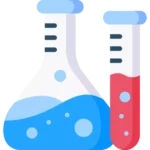Guess paper Biology for Class 9 is up-to-date and the most important questions are given according to Punjab boards. These guess papers 2025 help you to get the highest marks in your papers. Punjab Board guess paper 2025 Biology is relevant to all chapters and we have tried to put all necessary questions that help students to score more than seventy percent.
9th class Biology Guess paper 2025 is available, and you may ask if you need any assistance from our qualified team. Biology Class 9 Guess papers 2025 are for helping material that may enhance the chances of the students getting more marks in less time.
Guess Paper Biology Class 9 2025
9th Class Important Short Question of Biology
Chapter 1
- Define biotechnology.
- What is meant by horticulture and also define its relationship with agriculture?
- Define microbiology.
- Define biochemistry and morphology.
- Differentiate between morphology and physiology.
- Define parasitology.
- Define immunology.
- Differentiate between environmental and cell biology.
- What are medicine and surgery?
- Define pharmacology and immunology.
- What is the difference between agriculture and horticulture?
- What is meant by animal husbandry?
- Describe the major contributions of Jabir Bin Hayan.
- Write down the contributions of Abdul Malik Asmai.
- What are the contributions of Bu Ali Sina?
- From which two words is the word biology derived?
- Differentiate between botany and zoology.
- Differentiate between entomology and immunology.
- How does biology help in the field of horticulture?
- Briefly describe the biosphere level.
- Differentiate between vegetative and reproductive organs.
- Write down the levels of organization sequence.
- What is meant by bio elements?
- Differentiate between unicellular and multicellular.
- Differentiate between species and habitat.
- The organ system level of animals is more complex than ants, why?
- Differentiate between population and community.
- Write down the difference between tissue and organ.
- What is the scientific name of a mustard plant and a frog?
- Write uses of the mustard plant.
- What are micromolecules?
- What are macromolecules?
Chapter 2
- Differentiate between theory and law.
- Quantitative observation in the biological method is more accurate. How?
- Define biological method.
- Give examples of qualitative and quantitative observations.
- What is a scientific method?
- How quantitative observations are better than biological methods?
- What is a biological problem?
- Write down the important observations of A.F.A King.
- What is meant by the incubation period?
- Man has been a biologist for a long. Explain.
- Write two controls of malaria.
- Define hypothesis.
- Which characteristics should a hypothesis have?
- Define a deduction.
- Define a control group.
- What is meant by reporting the results?
- Differentiate between deduction and theory.
- Define a law or a principle.
- What is a productive theory?
- Differentiate between qualitative and quantitative observations.
- Differentiate between the control and experimental group.
- Write down the observations of Leveran.
- Define ratio and proportion.
- Write the definition of bioinformatics.
Chapter 3
- Define biodiversity.
- What is the importance of biodiversity (for humans)?
- How are taxonomy and systematics related?
- What is the aim of classification?
- Define the taxonomic hierarchy.
- Write the scientific name of man, frog, and pea.
- What are class and order?
- Define species and genus.
- Write down the cross due to which the mule produced.
- Describe the contributions of Carious Linnaeus.
- Differentiate between class and order.
- Write down the characteristics of a kingdom Moneta.
- What are the characteristics of the kingdom Protista?
- How many types of protists are there? Write their names.
- Write down the characteristics of kingdom fungi.
- Discuss whether viruses are living or nonliving.
- What are prions and viroid?
- Define binomial nomenclature.
- Write two rules for giving scientific names to living organisms.
- Write down the scientific names of human beings and pea plants.
- Differentiate between the terms extinct and endangered species.
- Define endangered species. Write an example.
- What are the causes of deforestation?
- Name three endangered species in Pakistan.
- Which is the national animal of Pakistan?
- What is meant by biosphere level?
- Briefly introduce the Houbara bustard and Marco Polo sheep.
- Differentiate between flora and fauna.
- What is the difference between autotrophs and heterotrophs?
Chapter 4
- Define magnification.
- Define resolving power or resolution.
- Define microscopy and magnification.
- Write down any two principles included in a cell theory.
- What is the function of leucoplasts and chromoplasts?
- Define plasmodesmata.
- Define a semi-permeable membrane.
- Write down the functions of the cell membrane.
- What is the fluid mosaic model of the cell membrane?
- Write two functions of the cytoplasm.
- What are leucoplasts and where do they occur?
- Why endoplasmic reticulum is called rough and smooth endoplasmic reticulum?
- What are the functions of smooth endoplasmic reticulum?
- What is the role of the nucleus in a cell?
- Differentiate between centrosomes and centrioles.
- What is phragmoplast?
- What is the difference between the primary and secondary walls of a cell wall of ants?
- What is the difference between microtubules and microfilaments?
- Give the chemical structure of the cell wall of eukaryotes.
- Differentiate between the plasma membrane and cell membrane.
- Write the functions of Golgi apparatus.
- What is cytoplasm? Write down its composition.
- What is chromatin?
- Write down the difference between chromoplasts and leucoplasts.
- Differentiate between diffusion and facilitated diffusion.
- What is meant by hypertonic and hypotonic solution?
- Differentiate between diffusion and osmosis.
- Define passive transport.
- Define facilitated diffusion.
- Define plasmolysis.
- Define active transport.
- Differentiate between endocytosis and exocytosis.
- Differentiate between phagocytosis and pinocytosis.
- Define endocytosis. and write the names of its types.
- Define turgor pressure and turgor.
- Differentiate between Simple compound tissues in lants
- Define support tissues- Write its types.
- Write functions of xylem and phloem tissues.
Chapter 5
- Define cell cycle.
- What is meant by G1 phase in a cell cycle?
- Explain G0 phase.
- What is interphase. Write the names of its phases.
- Define germ line cells.
- Differentiate between somatic and germ line cells.
- Differentiate between chromatin and chromosomes.
- Define mitosis. In which cells does it occur?
- Differentiate between karyokinesis and cytokinesis.
- Define cleavage furrow.
- What are tumors? Give an example.
- What is meant by regeneration? Give example.
- What is the difference between benign and malignant tumor?
- Why are tumors dangerous for human body?
- Define metastasis.
- What is mitotic spindle?
- What is alternation of generation?
- What is binary fission?
- Define crossing over.
- Define chiasmata.
- Define Meiosis and mitosis.
- What is the difference between disjunction and non-disjunction?
- What are the effects of errors in meiosis?
- When and Who discovered meiosis for the first time?
- What is necrosis? Write down its two causes.
- Differentiate between apoptosis and blebs,
- What is phragmoplast?
Chapter 6
- Differentiate between catabolism and anabolism.
- Define the terms enzyme and substrate.
- Define activation energy. How enzymes affect it?
- Define active site. Also, write its function.
- Define inhibitors,
- Define cofactors.
- What are prosthetic groups?
- Differentiate between cofactors and coenzymes.
- Write the difference between active site and substrate.
- Differentiate between protease enzyme and amylase
- What is lock and key model?
- What is induced fit model?
- What is the difference between intracellular and extracellular enzymes?
- What is substrate concentration?
- What do you mean by specificity of enzymes?
Chapter 7
- What is the difference between oxidation and reduction?
- Define ATP.
- Define photosynthesis. Write its equation.
- Write dawn the necessary conditions for photosynthesis.
- What are light reactions?
- What are dark reactions?
- What are different pigments in chloroplast?
- Define the term limiting factors in photosynthesis. Also, give an example.
- What is the role of light in photosynthesis?
- Define osmosis.
- What is the difference between light reactions and dark reactions?
- Define aerobic respiration,
- Define respiration and cellular respiration.
- Define alcoholic fermentation
- Define lactic acid fermentation.
- Define glycolysis, where does this process occur?
- What is the importance of aerobic and anaerobic res [ration?
- What is Krebs cycle?
- What are differences between respiration and otos thesis?
- What are the differences between aerobic and anaerobic respiration?
- What do you know about electron transport chain?
Chapter 8
- Define nutrition.
- What are nutrients?
- Which are autotrophic and heterotrophic organisms?
- Differentiate between nutrient and nutrition.
- What is the difference between organic and inorganic fertilizers?
- Differentiate between macronutrients and micronutrients.
- What IS the importance of fertilizers in agriculture?
- What is the role of calcium and magnesium in plants life?
- What is the role of magnesium in plants?
- How can the deficiency of vitamin A cause blindness?
- Write down the sources of carbohydrates.
- What are the important sources of lipids?
- What is the difference between saturated and unsaturated acids?
- Write any two roles of calcium in human,
- What role is played by iron in humans?
- What is goiter? How can it be cured?
- Differentiate between fat soluble and water-soluble vitamins.
- From which sources vitamin A and vitamin D are obtained?
- What are the functions of vitamin A, C and D?
- Write dawn the names of diseases caused by the deficiency pf vitamin A.
- Write dawn name of two diseases produced due to deficiency of vitamin D.
- Deficiency of which vitamin causes osteomalacia? Write down one problem.
- What is scurvy? Write down its symptoms.
- What are the sources of soluble dietary fibers?
- Is balanced diet?
- Define malnutrition? Also give the names of any two types of malnutrition.
- What is protein energy malnutrition?
- Name the major causes of famine,
- What is meant by starvation?
- What is drought? Write its two disadvantages.
- Write symptoms of goiter and anemia.
- Write sources and effects due to the deficiency of vitamin D.
- What is night blindness?
- How will you differentiate between bolus and chime?
- Differentiate between ingestion end gestion?
- Write the names of various parts of alimentary canal-
- What is a sphincter?
- Is the difference between cardiac sphincter and pyloric sphincter?
- What is gastric juice? Name the enzyme present in gastric urine.
- Write a short note on gastric gland.
- What is appendix?
- Write two functions of large intestine
- What do you know about liver?
- What is the role of liver in digestive system?
- Write any three functions of liver.
- Differentiate between eutrophication and ingestion.
- Differentiate between assimilation and absorption.
- What is diarrhea? How can it be cured?
- What are causes of diarrhea?
- What are the cases of constipation?
- What are the major causes of ulcer?
- Enlist preventive measures to save from ulcer.
Chapter 9
- What are lenticels and where are they found in a plant body?
- Define the cohesion-tension theory.
- What do you mean by sources and sinks acceding to the pressure flow mechanism?
- What is the function of xylem tissue?
- What is the function of Phloem tissue?
- Define transpiration,
- What are lenticels? Where are they found in plant body?
- What is the importance of transpiration?
- What is transpiration pull?
- Write down two reasons for creation of transpiration pull
- Why transpiration is called a necessary evil?
- What is the effect of humidity on the rate of transpiration?
- What is stomatal transpiration?
- Differentiate between mesophyll cells and guard cells.
- What is osmosis?
- How temperature affects transpiration?
- What are the two main types of white blood cells? How do they differ?
- Define the terms systole and diastole.
- Differentiate between arteries and veins,
- What is blood? Write down the actual volume of blood in an adult human.
- What is fibrinogen? Write down Its function.
- Write down the names of two systems of transport of materials in humans.
- Define the closed blood circulatory system and also write two main components of the human blood circulatory system.
- Define pulmonary circulation.
- What is systemic circulation?
- Differentiate between antigens and antibodies.
- What are the differences between granulocytes and agranulocytes?
- What are white blood cells? Name its two main types.
- Write the functions of neutrophils and basophils.
- What are platelets? What is their function?
- Who are called universal recipients? Why?
- What is the Rh blood group system?
- How does the human heart work as a double pump?
- What is the relation between heartbeat and pulse rate?
- Differentiate between arteries and capillaries,
- Write down the nature of the function of a vascular surgeon.
- Why bypass surgery is done?
- Write down two achievements of William Harvey,
- What is thalassemia?
- What is pericardial fluid? What is its function?
- Differentiate between cardiac diastole and ventricular stole.
- What is meant by cardiac cycle?
- Write the function of the stethoscope.
- What is meant by angina pectoris? Write symptoms,
- What is arteriosclerosis? What is dengue?
- What are plaques?
- What is meant by atherosclerosis?
- What are the universal donor and universal recipient?
- What is cardiovascular disease? What is their cause?
- What is atherosclerosis?
9th Class Important Long Question of Biology
Chapter 1
- Define biology. Describe its branches.
- Describe relation of biology with other sciences.
- Explain five careers of biology.
- Define and explain tissue level.
- Write a note on population and community.
- Write a note on organ system level.
- Write a note on unicellular, multicellular and colonial.
Chapter 3
- Describe binomial nomenclature and its significance.
- Write a note on Five Kingdom classification system.
- Describe the importance of forest.
- Write a note on endangered species in Pakistan.
Chapter 4
- Write a note on nucleus with diagram.
- Write a note on mitochondria with diagram.
- Explain plastids.
- Differ b/w prokaryotic and eukaryotic cell.
Chapter 7
- Describe the mechanism of respiration.
- Write a note on light reaction with summary.
- Write a note on sketch the dark reaction.
- Write a note on ATP. Write its structure and function.
- Write a note on energy budget of respiration.
Chapter 8
- Write a note on digestion in stomach.
- How digestions occur in small intestine?
- How digestions occur in oral cavity or functions of oral cavity?
- Explain role of liver in our body.
Chapter 9
- Explain transport of water in plants.
- Explain transport of food in plants.
- What is transpiration? Write factors which effect o it.
- Write a note on human heart with diagram.
- Explain myocardial infarction.
- Write a short note on arterial system.
- Write a short note on venus system.
- What is transpiration pull? Why it is called necessary evil?
- Write a short note on plasma, RBC’s and WBC’s.
More Long Questions Important According to the Punjab Board
- Write a note on different branches of biology. Explain any four.
- What do you know about the nucleus? Write its structure and function.
- What are the offerings that a biology student can plan to adopt? Describe the details of each one.
- What are plastids? Give their different types. Write their structure and functions.
- Describe the work of some Muslim scientists.
- Explain the difference between prokaryotic and eukaryotic cells.
- Describe briefly the organ and organ system level with examples.
- What is a tissue? Describe the major animal tissues in terms of their cell specificities, locations, and functions.
- How many organizations of cells are there in the formation of bodies of organisms? Explain each.
- Write down the characteristics of enzymes.
- Explain the role of chlorophyll and light in photosynthesis and also describe the mechanism of respiration.
- Describe the uses of enzymes in different industries.
- Write down the summary of the events of light reactions.
- Describe the factors that affect the rate of enzyme action.
- What is photosynthesis? Write its importance. How the process of photosynthesis can be represented by the general equation.
- What do you know about the specificity of enzymes? Explain With the help of different examples. How the specificity of enzymes is determined?
- What is meant by ATP? Write some of its functions. Also, write the chemical structure of the ATP molecule.
- Write down the importance of fertilizers.
- Write down the significance of transpiration.
- Describe the role of calcium and iron in the human body.
- Describe the symptoms, causes, and treatments of blood disorders leukemia (blood cancer) and thalassemia.
- Describe the importance of water and dietary fibers in the human body.
- Write a detailed note on blood vessels.
- Describe the effects of malnutrition.
- What is meant by myocardial infarction? Describe its causes, uses, and symptoms.
- Describe the role of the liver in the human body.
- How do different factors affect the rate of transpiration?
- Write the detail of three human diseases in the alimentary canal.
- Describe the mechanism of opening and closing of stomata.
Guess Papers for Class 9
Schemes of Class 9
Click here for the 9th Class MCQs Test











